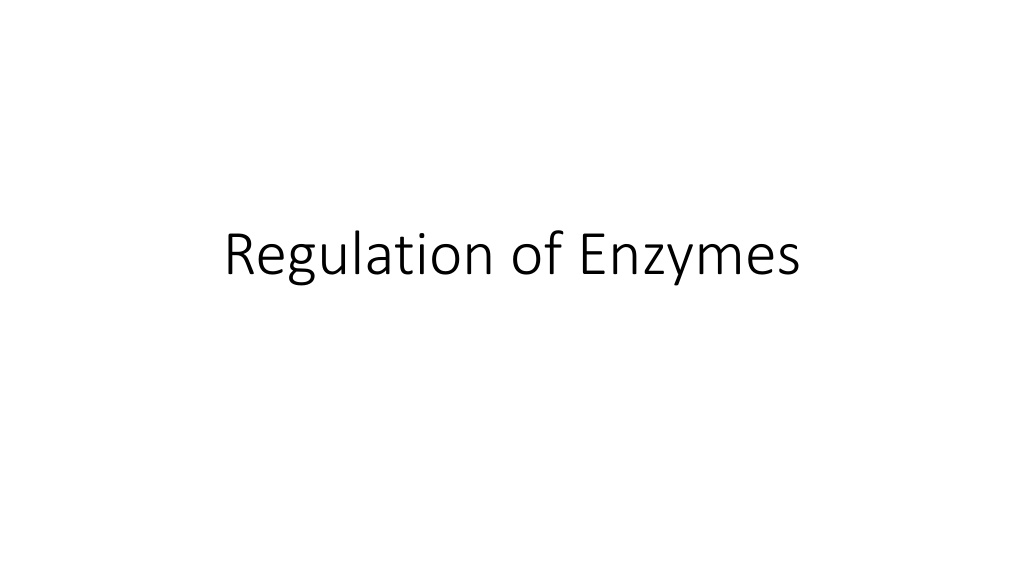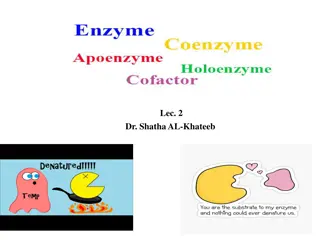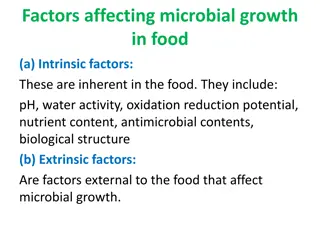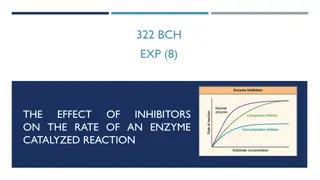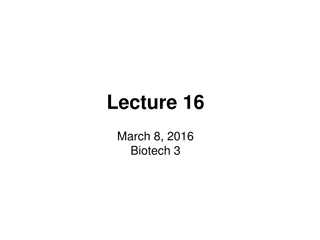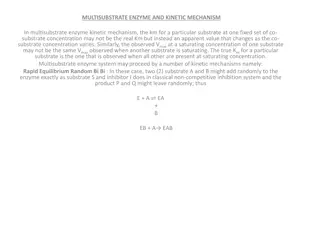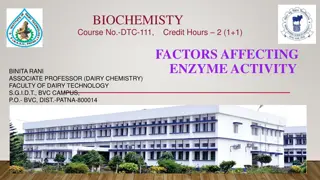Understanding Enzyme Regulation and Factors Affecting Enzyme Activity
Organisms carefully control enzyme production and activation as per varying needs and conditions within cells. Enzyme activity is influenced by factors such as pH, temperature, regulatory molecules, cofactors, compartmentalization, covalent modification, and feedback inhibition. Enzymes can be regulated by activators and inhibitors, with reversible inhibitors categorized as competitive or noncompetitive based on their binding interactions with enzymes.
Download Presentation

Please find below an Image/Link to download the presentation.
The content on the website is provided AS IS for your information and personal use only. It may not be sold, licensed, or shared on other websites without obtaining consent from the author. Download presentation by click this link. If you encounter any issues during the download, it is possible that the publisher has removed the file from their server.
E N D
Presentation Transcript
Organisms do not produce and activate all of those enzymes at the same time, or in the same cell. Needs and conditions vary from cell to cell and change in individual cells over time. Because enzymes guide and regulate the metabolism of a cell, they tend to be carefully controlled.
Factors affecting enzyme activity https://youtu.be/LKiXfqaWNHI https://www.youtube.com/watch?v=yk14dOOvwMk pH and temperature Regulatory molecules. Enzyme activity may be turned "up" or "down" by activator and inhibitor molecules that bind specifically to the enzyme. Cofactors. Many enzymes are only active when bound to non-protein helper molecules known as cofactors. Compartmentalization. Storing enzymes in specific compartments can keep them from doing damage or provide the right conditions for activity. Covalent Modification: The covalent attachment of another molecule can modify the activity of enzymes and many other proteins. In these instances, a donor molecule provides a functional moiety that modifies the properties of the enzyme. Phosphorylation and dephosphorylation are the most common but not the only means of covalent modification. Feedback inhibition. Key metabolic enzymes are often inhibited by the end product of the pathway they control (feedback inhibition).
Regulatory molecules Enzymes can be regulated by other molecules that either increase or reduce their activity. Molecules that increase the activity of an enzyme are called activators, while molecules that decrease the activity of an enzyme are called inhibitors.
Reversible inhibitors Activator or inhibitor's binding is reversible, meaning that the molecule doesn't permanently attach to the enzyme. Two important groups: competitive and noncompetitive inhibitors. Competitive inhibition An inhibitor may bind to an enzyme and block binding of the substrate, for example, by attaching to the active site. This is called competitive inhibition, because the inhibitor competes with the substrate for the enzyme. That is, only the inhibitor or the substrate can be bound at a given moment. If an inhibitor is competitive, it will decrease reaction rate when there's not much substrate, but can be "out-competed" by lots of substrate. That is, the enzyme can still reach its maximum reaction rate given enough substrate. In that case, almost all the active sites of almost all the enzyme molecules will be occupied by the substrate rather than the inhibitor.
Noncompetitive inhibition The inhibitor doesn't block the substrate from binding to the active site. Instead, it attaches at another site and blocks the enzyme from doing its job. This inhibition is said to be "noncompetitive" because the inhibitor and substrate can both be bound at the same time. If an inhibitor is noncompetitive, the enzyme-catalyzed reaction will never reach its normal maximum rate even with a lot of substrate. This is because the enzyme molecules with the noncompetitive inhibitor bound are "poisoned" and can't do their job, regardless of how much substrate is available.
Allosteric regulation Regulation where the regulatory molecule (an activator or inhibitor) binds to an enzyme someplace other than the active site. The place where the regulator binds is called the allosteric site. Allosteric enzymes typically have multiple active sites located on different protein subunits. When an allosteric inhibitor binds to an enzyme, all active sites on the protein subunits are changed slightly so that they work less well.
Some allosteric activators bind to locations on an enzyme other than the active site, causing an increase in the function of the active site. Also, in a process called cooperativity, the substrate itself can serve as an allosteric activator: when it binds to one active site, the activity of the other active sites goes up.
Cofactors and coenzymes Many enzymes need non-protein helper molecules called cofactors. Some are attached temporarily to the enzyme through ionic or hydrogen bonds, or permanently through stronger covalent bonds. Common cofactors include inorganic ions such as iron and magnesium. For example, the enzyme that builds DNA molecules, DNA polymerase, requires magnesium ions to function Coenzymes are a subset of cofactors that are organic (carbon-based) molecules. The most common sources of coenzymes are dietary vitamins. Some vitamins are precursors to coenzymes and others act directly as coenzymes. For example, vitamin C is a coenzyme for several enzymes that take part in building the protein collagen, a key part of connective tissue.
Enzyme compartmentalization Enzymes are often compartmentalized (stored in a specific part of the cell where they do their job) -- for instance, in a particular organelle. Compartmentalization means that enzymes needed for specific processes can be kept in the places where they act, ensuring they can find their substrates readily, don't damage the cell, and have the right microenvironment to work well. Digestive enzymes of the lysosome work best at a pH around 5.05.05, point, 0, which is found in the acidic interior of the lysosome (but not in the cytosol, which has a pH of about 7.27.27, point, 2). Lysosomal enzymes have low activity at the pH of the cytosol, which may serve as "insurance" for the cell: even if a lysosome bursts and spills its enzymes, the enzymes will not begin digesting the cell, because they will no longer have the right pH to function.
Feedback inhibition The end product of a metabolic pathway acts on the key enzyme regulating entry to that pathway, keeping more of the end product from being produced. When there s little of the product, the enzyme will not be inhibited, and the pathway will go full steam ahead to replenish the supply. When there s lots of the product sitting around, it will block the enzyme, preventing the production of new product until the existing supply has been used up.
Feedback inhibition acts at the first committed step of the pathway, meaning the first step that s effectively irreversible. However, feedback inhibition can sometimes hit multiple points along a pathway as well, particularly if the pathway has lots of branch points. The pathway steps regulated by feedback inhibition are often catalyzed by allosteric enzymes.
The energy carrier molecule ATP is an allosteric inhibitor of some of the enzymes involved in cellular respiration, a process that makes ATP to power cellular reactions. When there is lots of ATP, this feedback inhibition keeps more ATP from being made. This is useful because ATP is an unstable molecule. If too much ATP were made, much of it might go to waste, spontaneously breaking back down into its components (ADP and Pi). ADP, on the other hand, serves as a positive allosteric regulator (an allosteric activator) for some of the same enzymes that are inhibited by ATP. For instance, ADP may act by binding to an enzyme and changing its shape so that it becomes more active.
Co factor Function Example Mg Whereever ATP is used Kinases Fe Catalase, SOD, Peroxidase, Cyt
https://www.youtube.com/watch?v=Cck3US2EBmU https://www.youtube.com/watch?v=4aVOtcpGaZc
